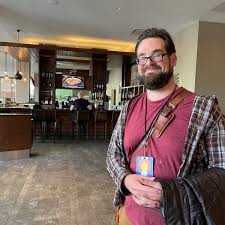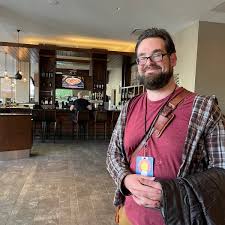The Power of Shared Storytelling: An Interview with Thomas Wilson

Welcome back to the podcast blog! This week, we had the incredible opportunity to sit down with Thomas Wilson, founder of R&H Creative Advocacy and Storytelling, to delve into the fascinating world of shared storytelling. In this post, we'll expand on the key concepts discussed in the episode, exploring how Thomas utilizes shared storytelling to connect with diverse audiences, create impactful narratives, and foster a sense of community. We'll also provide actionable steps you can take to integrate these techniques into your own life and work. Ready to unlock the transformative power of shared stories? Let's dive in!
You can find the full episode, Thomas Wilson, on our podcast page. We encourage you to listen to the interview for even more insights and anecdotes from Thomas himself.
Introduction: Unveiling the Power of Shared Storytelling
In today's hyper-connected world, the ability to connect authentically with others is more crucial than ever. Storytelling, an age-old art form, remains one of the most powerful tools we have for building bridges, fostering empathy, and creating a sense of belonging. But what happens when we move beyond simply telling our own stories and begin to weave them together with the experiences of others? That's where the magic of shared storytelling comes into play.
Shared storytelling is more than just exchanging anecdotes. It's about actively listening to, understanding, and integrating the stories of others into our own narratives. It's a collaborative process that acknowledges the inherent value and validity of diverse perspectives. By embracing shared storytelling, we can break down barriers, challenge preconceived notions, and create richer, more meaningful connections with the world around us.
Who is Thomas Wilson? Founder of R&H Creative Advocacy and Storytelling
Thomas Wilson is a passionate advocate, storyteller, and speaker with over a decade of experience in the field. As the founder of R&H Creative Advocacy and Storytelling, he has dedicated his career to helping individuals and organizations harness the power of narrative to achieve their goals. Thomas’s work is rooted in the belief that everyone has a story to tell, and that by sharing these stories, we can create positive change in the world.
With a background in professional writing and extensive involvement in various communities, Thomas brings a unique blend of skills and perspectives to his work. He possesses a deep understanding of how empathy and compassion-based care can sustain meaningful narratives, and he is committed to using his expertise to amplify the voices of those who are often marginalized or unheard.
What is Shared Storytelling?
Shared storytelling, at its core, is a collaborative and inclusive approach to narrative creation. It's about recognizing that stories are not static, individual entities, but rather dynamic and interconnected threads that weave together to form a larger tapestry of human experience. Unlike traditional storytelling, where a single narrator holds the sole authority over the narrative, shared storytelling invites multiple voices to contribute, shape, and interpret the story.
Here are some key elements that define shared storytelling:
- Active Listening: Shared storytelling begins with a genuine desire to hear and understand the stories of others. This requires active listening, which means paying attention not only to the words being spoken, but also to the emotions, body language, and cultural context behind them.
- Empathy and Compassion: To truly embrace shared storytelling, we must cultivate empathy and compassion. This involves putting ourselves in the shoes of others, recognizing their shared humanity, and acknowledging the validity of their experiences, even if they differ from our own.
- Collaboration and Co-creation: Shared storytelling is a collaborative process that involves co-creating narratives with others. This can take many forms, from simply incorporating the perspectives of others into our own stories to engaging in joint writing or performance projects.
- Respect and Inclusivity: Shared storytelling is grounded in respect for the diversity of human experience. It seeks to create spaces where all voices are valued and heard, regardless of background, identity, or perspective.
- Meaning-Making: Ultimately, shared storytelling is about creating meaning together. By sharing our stories, we can gain new insights into ourselves, our communities, and the world around us.
R&H Creative Advocacy and Storytelling: Partnering for Impact
R&H Creative Advocacy and Storytelling is a testament to the power of shared storytelling in action. Thomas Wilson founded the organization with the mission of partnering with businesses and organizations across Colorado to deliver high-quality events and services to communities in need. By leveraging the art of shared storytelling, R&H Creative Advocacy and Storytelling helps its partners craft impactful, creative content that deeply resonates with diverse audiences.
Some of the key partners of R&H Creative Advocacy and Storytelling include:
- Angels Service LLC: Providing compassionate and supportive services to individuals with disabilities.
- Tabula Sono: Creating inclusive and accessible music experiences for people of all abilities.
- Autism Minds Co: Offering resources and support for individuals and families affected by autism.
- APSE (Association of People Supporting Employment First): Promoting integrated employment opportunities for individuals with disabilities.
- COEF Speakers Bureau: Connecting organizations with speakers who can share their expertise on a variety of topics.
- Dirt Coffee: A coffee shop that provides employment opportunities for individuals with disabilities.
Through these partnerships, R&H Creative Advocacy and Storytelling is making a tangible difference in the lives of individuals and communities across Colorado. By empowering people to share their stories and connect with one another, the organization is fostering a more inclusive, equitable, and compassionate world.
Thomas Wilson's Community Involvement
Thomas Wilson's commitment to shared storytelling extends far beyond his work with R&H Creative Advocacy and Storytelling. He is an active member of several community organizations, where he leverages his expertise to promote inclusivity, advocacy, and connection.
Here are some of the key roles Thomas plays in his community:
- Colorado APSE Board and Communication Committee Member: Thomas contributes his expertise to the Association of People Supporting Employment First, advocating for integrated employment opportunities for individuals with disabilities. His involvement helps shape policies and initiatives that promote a more inclusive workforce.
- Colorado Employment Speakers Committee Member: Thomas helps connect organizations with speakers who can share their expertise on employment-related topics. This ensures that businesses and communities have access to valuable information and resources.
- Collaborator with Adults with High Functioning Autism of Colorado: Thomas works closely with one of the largest and fastest-growing Meetup groups focused on Autism in the state. He provides support, guidance, and resources to individuals on the autism spectrum, fostering a sense of community and belonging.
Through his community involvement, Thomas demonstrates his unwavering dedication to using shared storytelling as a tool for positive change. He recognizes that by working together and amplifying the voices of those who are often marginalized, we can create a more just and equitable society for all.
How Shared Storytelling Resonates with Diverse Audiences
One of the most remarkable aspects of shared storytelling is its ability to resonate with diverse audiences. By incorporating multiple perspectives and experiences into a narrative, shared storytelling can create a sense of connection and understanding that transcends cultural, social, and linguistic barriers. When people see themselves reflected in a story, they are more likely to feel engaged, empowered, and motivated to take action.
Here are some reasons why shared storytelling resonates so powerfully with diverse audiences:
- Authenticity: Shared stories are often more authentic and relatable than traditional narratives, as they reflect the real-life experiences of a variety of individuals. This authenticity can build trust and create a stronger connection with audiences.
- Inclusivity: Shared storytelling actively seeks to include diverse voices and perspectives, ensuring that marginalized groups are represented and heard. This inclusivity can foster a sense of belonging and empower individuals to share their own stories.
- Empathy: By exposing audiences to a range of perspectives, shared storytelling can promote empathy and understanding. This can help break down stereotypes, challenge preconceived notions, and foster a more compassionate society.
- Relevance: Shared stories are often more relevant to diverse audiences than traditional narratives, as they address issues and concerns that are specific to their experiences. This relevance can make the story more engaging and impactful.
- Empowerment: Shared storytelling can empower individuals to take ownership of their own narratives and become active participants in shaping the story. This can lead to a greater sense of agency and a stronger commitment to creating positive change.
Applying Shared Storytelling in Your Life and Work
Now that we've explored the power of shared storytelling, let's discuss how you can apply these techniques in your own life and work. Whether you're a business leader, a community organizer, a teacher, or simply someone who wants to connect more authentically with others, shared storytelling can be a valuable tool for building relationships, fostering empathy, and creating positive change.
Here are some actionable steps you can take to integrate shared storytelling into your daily life:
- Practice Active Listening: Make a conscious effort to listen more attentively to the stories of others. Pay attention to their words, emotions, and body language. Ask clarifying questions and try to understand their perspective.
- Seek Out Diverse Perspectives: Actively seek out opportunities to connect with people from different backgrounds, cultures, and experiences. Attend community events, join online forums, or volunteer with organizations that serve diverse populations.
- Create Safe Spaces for Sharing: Foster environments where people feel comfortable sharing their stories without fear of judgment or criticism. This could involve creating a support group, hosting a storytelling event, or simply being a supportive and empathetic listener.
- Incorporate Stories into Your Work: Find ways to incorporate stories into your work, whether it's through marketing campaigns, employee training programs, or community outreach initiatives. Use real-life examples and personal anecdotes to connect with your audience on an emotional level.
- Collaborate on Storytelling Projects: Partner with others to co-create narratives that reflect a variety of perspectives and experiences. This could involve writing a book together, producing a documentary, or developing a theater production.
- Share Your Own Story: Don't be afraid to share your own story with others. Your experiences, both positive and negative, can be a source of inspiration, connection, and learning for those around you.
Conclusion: The Enduring Impact of Shared Stories
As we've explored throughout this blog post and in our conversation with Thomas Wilson on the latest podcast episode, the power of shared storytelling lies in its ability to connect us, inspire us, and empower us to create positive change in the world. By embracing the principles of active listening, empathy, and collaboration, we can unlock the transformative potential of shared narratives and build a more inclusive, equitable, and compassionate society.
Remember, every story matters. Every voice deserves to be heard. By weaving together our individual narratives, we can create a powerful tapestry of human experience that enriches our lives and inspires us to work towards a better future for all. So, let's continue to share our stories, listen to the stories of others, and work together to create a world where everyone feels seen, valued, and empowered.









